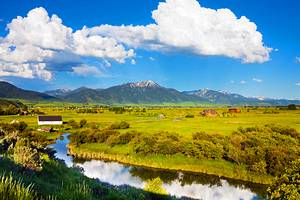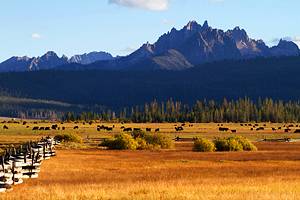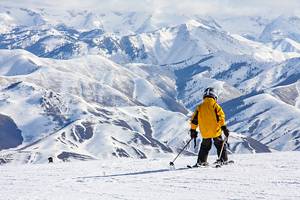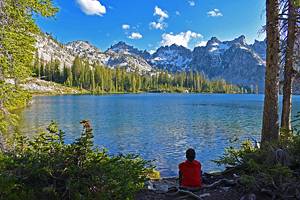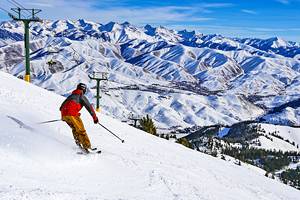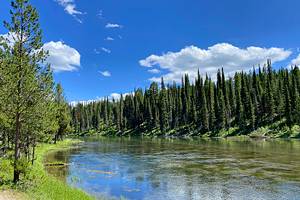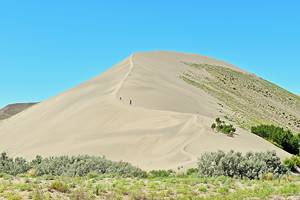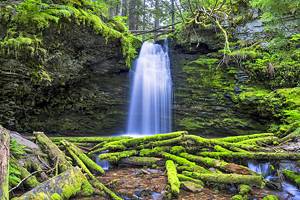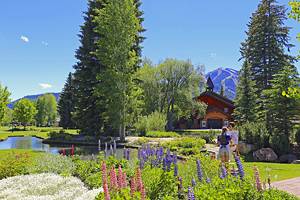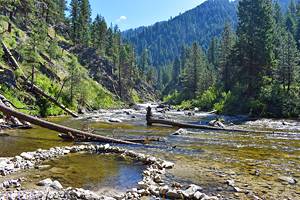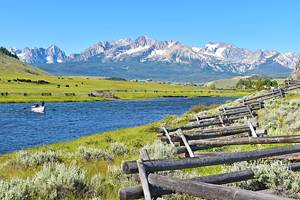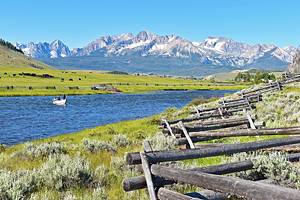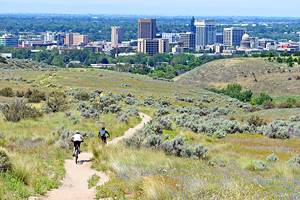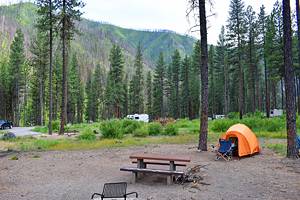Places for White Water Rafting in Idaho
Author Brad Lane has taken several reporting trips throughout Idaho.
White water in Idaho is epic. The state has some of the best paddling and rafting opportunities in North America.
Several Wild and Scenic Rivers carve their way across Idaho and through some of the country's deepest canyons. These rip-roaring rivers also pass through dense forests with luscious mountainsides and intense beauty. Above all, these rafting hot spots feature miles of classic white-water adventure.
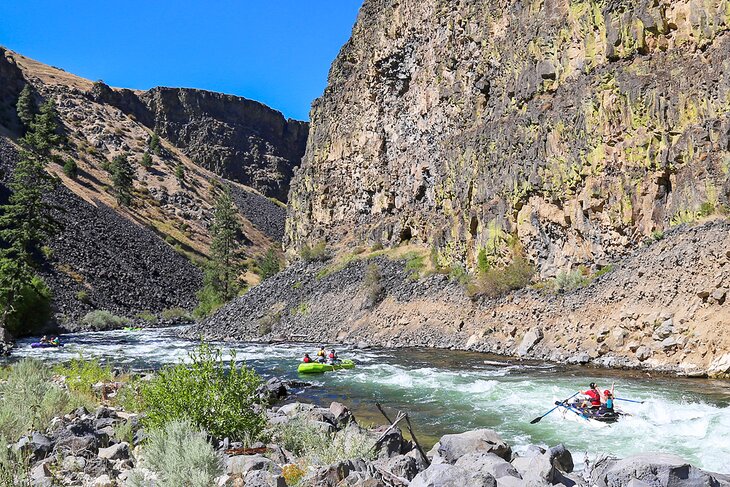
Depending on the river, Idaho's rafting and paddling season takes place between May and September. The months of May and June are ideal for most white-water trips in Idaho, when the rivers run cold with snowmelt. Advance permits administered by the U.S. Forest Service are required to run some of the state's most famous rivers.
A popular way to experience Idaho white water is with a commercial guide. Several guiding companies operate throughout the state. Every river mentioned below has at least one outfitter running boats. Whichever way you ride, prepare for no other state's white water to ever compare.
Find your next early summer adventure with our list of white-water rivers in Idaho.
Salmon River
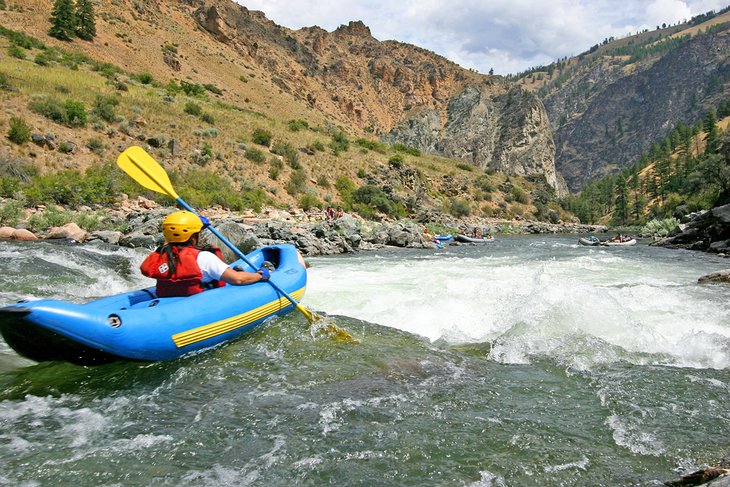
Known as the "River of No Return," the Salmon River is protected by Congress as one of the first Wild and Scenic Rivers in the nation. The river cuts through large sections of the Frank Church Wilderness, one of the largest designated wildernesses in the lower 48. The pristine beauty of this deep river canyon, and the miles of unimpeded rapids, make the Salmon one of the best white-water rivers in North America.
Trips on the Salmon are generally divided between three sections: the Main Salmon, the Middle Fork of the Salmon River, and the Lower Salmon. Each stretch of the river rivals the others in beauty, with rapids ranging from Class II to Class IV. Several commercial outfitters offer trips on each section of the river.
Trips on the Main Salmon typically span 80 miles and upwards of six days. Several trips start at Corn Creek Boat Launch and head downriver from there. Advance permits are required to access the Main Salmon between late June and early September. A lottery opens in December before the season. Prior paddling experience goes a long way on the Salmon, as the river features Class III-IV rapids.
The Middle Fork of the Salmon River is at the top of the white-water bucket list for most boaters. The river runs approximately 100 miles, with intense beauty the entire way. The river also loses over 3,000 feet in those 100 miles, which adds to prominent features like Tappan Falls and Devil's Tooth along the way. Highly competitive permits are also required to boat the Middle Fork.
The Lower Salmon offers more solitude in a Salmon River experience. The scenery doesn't come up short on the Lower Salmon, though. Before meeting the Snake River, and after spending the night on sandy beaches, the Lower Salmon is postcard-perfect during summer. Rapids on the Lower Salmon range from Class II to Class III, providing a better learning ground than the Main Salmon and Middle Fork.
Several outfitters run rafts on the Salmon throughout the season. Idaho River Journeys is one such reputable company operating out of the scenic community of Salmon. Idaho River Journeys runs about a dozen Middle Fork Salmon trips a year, each selling out fast.
Read More: Things to Do in Salmon, ID
Snake River through Hells Canyon
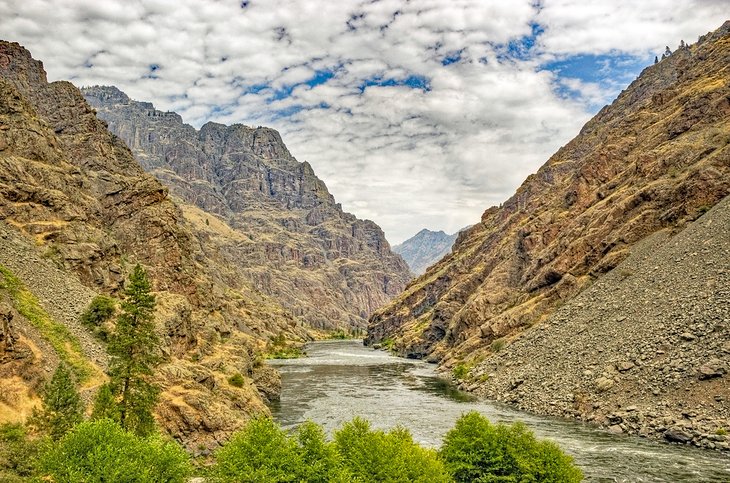
Straddling the border of north-central Idaho and Oregon, Hells Canyon is the deepest river canyon in North America, deeper than the Grand Canyon of Arizona. The depths of the canyon offer stunning views from the canyon's edge. And an even better perspective rewards those who paddle the Wild and Scenic Snake River below.
Snake River trips into Hells Canyon begin at Hells Canyon Dam. Permits are required to run the river between late May and mid-September. A lottery for permits opens in December before the rafting season.
Due to the competitiveness of this lottery, one of the most popular ways to raft the Snake River is with a professional guiding company. Several outfitters run trips on the Snake River through Hells Canyon. Trips generally range from three to five days. Hells Canyon Raft, out of McCall, is a longstanding rafting company that's been offering family-friendly trips for over 30 years.
Boaters encounter the majority of the Snake's Class III-IV rapids within its first 30 miles, from Hells Canyon Dam to Pittsburg Landing. Cultural artifacts like homesteader cabins also line this section of the river. So does a high potential for wildlife sightings.
Longer trips on the Snake River span up to 80 miles, with more flatwater on the second half - perfect for fishing rainbow trout.
Read More: National Forests in Idaho
Payette River
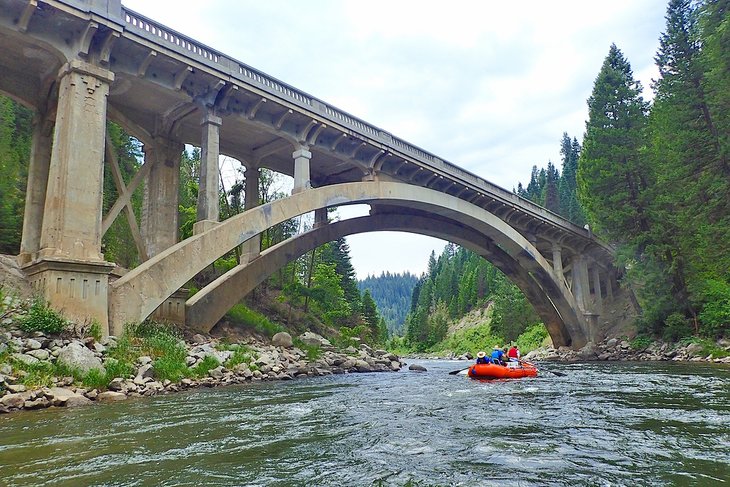
The Payette River is a popular white-water destination for Boise residents and beyond, within an hour's drive of the capital city. Three distinct sections comprise the Payette: the South Fork, North Fork, and Main Payette River.
The Main Payette River offers iconic Idaho rafting an hour from Boise. River trips start in the community of Banks, at the confluence of the South and North Forks of the Payette River. Spanning eight miles from Banks to Beehive Bend, the Main Payette is an excellent Class II-III playground for novice and seasoned rafters.
The South Fork of the Payette River has several scenic miles to paddle. Two popular sections are the fast-flowing Staircase and Canyon runs. The Staircase run has several Class IV rapids spread out over 4.5 miles, like the challenging Bronco Billy and Slalom rapids. The Canyon run presents comparable big water technicality, including a mandatory portage at the 40-foot Big Falls.
Several outfitters, like Payette River Company, offer fun trips on the South Fork of the Payette River. The company's Canyon Run is particularly popular, featuring a full-day adventure and over 25 rapids.
A popular section of the North Fork is between Cabarton Bridge and Smiths Ferry. This "Cabarton Section" of the river is also a popular paddling destination. The white water is calm to begin this nine-mile stretch. The action picks up downriver, with Class III features like Trestle Rapids and Howard's Plunge.
Selway River
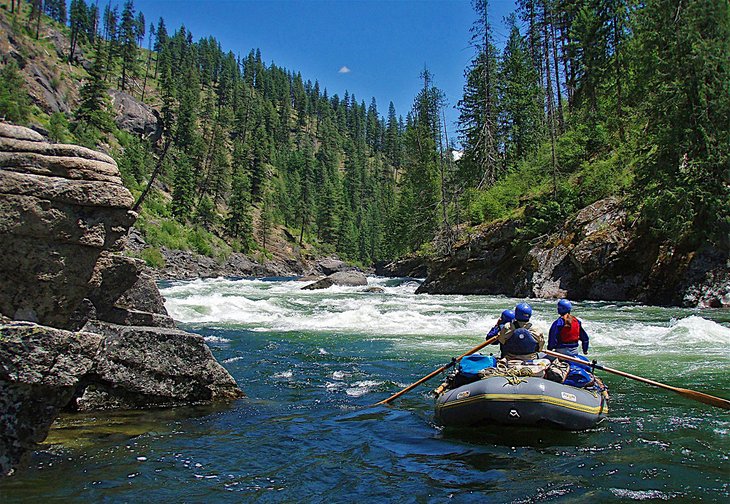
In north-central Idaho, the Selway River descends 100 miles from the Bitterroot Mountains to meet the Lochsa River. The elevation drops nearly 8,000 feet along this journey as the water rushes through wild Idaho country. The Selway is protected as a Wild and Scenic River and offers challenging rapids and unsurpassed scenery.
A major appeal of the Selway River is its solitude. The Forest Service allows very few daily launches on the river. Permits for professional guiding companies are also limited. Some guiding companies, like Selway River Adventures in Stanley, book out Selway River trips years in advance. The Forest Service opens a competitive lottery for individual boaters in December before the season.
On the Selway, white water adventures take off from the Paradise Boating Site at the confluence of the Selway River and White Cap Creek. Trips span approximately 47 miles, which generally takes five days to complete. Within the first 30 miles of the river, boaters encounter Class II-III rapids such as Slalom Slide and Goat Creek Rapid. The big water comes next, when Moose Creek joins the Selway.
After the extra water infusion from Moose Creek, sometimes known as "Moose Juice," the river picks up to end the trip with some steep rapids. Right after Moose Creek, rapids like Ladle and Double Drop batter boats around with Class IV action. The river continues with more Class IV rapids until takeout at Race Creek.
Read More: Things to Do in Stanley, ID
Lochsa River
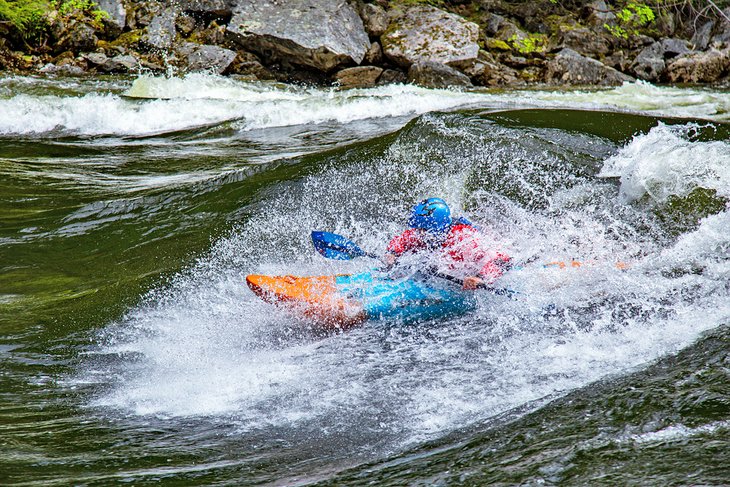
When the snow melts from higher elevations, the Lochsa River comes charging out of the Bitterroot Mountains. Pronounced "Lock-Saw," this Wild and Scenic River is a real treasure of the Gem State. The river is also a technical challenge for experienced boaters.
The entire river is approximately 70 miles long, much of which flows within the Nez Perce - Clearwater National Forest. The curving Northwest Passage Scenic Byway (Highway 12) follows the banks of the river. Trips on the Lochsa span one to three days, with variable distances made possible by abundant roadside pullouts.
Two popular sections of the river meet at the Wilderness Gateway Campground on Highway 12. The river's most infamous features, like Grim Reaper Rapid and Lochsa Falls, are within a 12-mile stretch downriver from the campground. These rapids run a stout Class IV between May and July and are not beginner-friendly.
The section upriver from Wilderness Gateway is also laced with great waves like Tenpin Alley. This section of the river spans 16 miles from Indian Grave Creek to the Wilderness Gateway Bridge.
A few rafting companies offer single-day trips on the Lochsa. Row Adventure Center, out of Coeur d'Alene, offers some of the most experienced guides to show you down the river. They generally only offer trips when the river is running best, approximately late May through late June.
Either section from the Wilderness Gateway Bridge makes for great day trips. And the campground offers the perfect place to spend the night. This river access, as well as access to the adjacent Selway-Bitterroot Wilderness, makes Wilderness Gateway Campground one of the best places to camp in Idaho.
St. Joe River
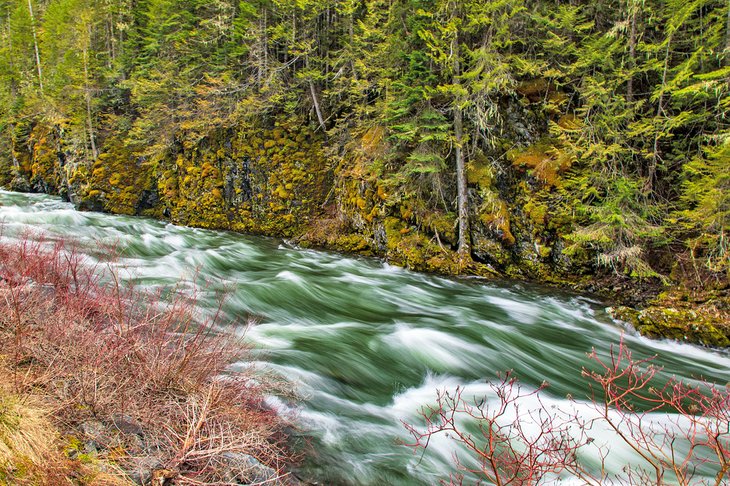
This scenic river in the Idaho Panhandle flows high from the mountains into Lake Coeur d'Alene. Sometimes given the moniker "Shadowy St. Joe" for its ambling downriver flow, the St. Joe is not as sleepy at its headwaters. Near its beginnings in St. Regis, Montana, the St. Joe offers excellent Class II-III white water that's perfect for beginners and bigger groups.
St. Joe River trips are typically done in a day. Several pullout options and places to leave a vehicle enable flexibility in trip planning. The white water on St. Joe is usually done self-supported, although a few outfitters, like ROW Adventure Center out of Coeur d'Alene, offer day trips between early June and early July.
The Tumbledown Section is a common stretch of river to paddle, which begins at the Conrad Crossing Forest Service Campground. The seven miles of river from the campground have consistent rapids to weave through. Many of the rapids are moderate until Tumbledown Falls, a Class IV series of crashing waves and drops.
Alongside its white water, the river is also known for its scenic attributes. Beneath the froth, the St. Joe River is sparkling clear enough to see trout swimming beneath the surface. The surrounding cedar forest also shines with a lush appeal, adding significant chances of seeing wildlife. If not for the waves, the St. Joe is worth visiting for the window into nature.
Bruneau River
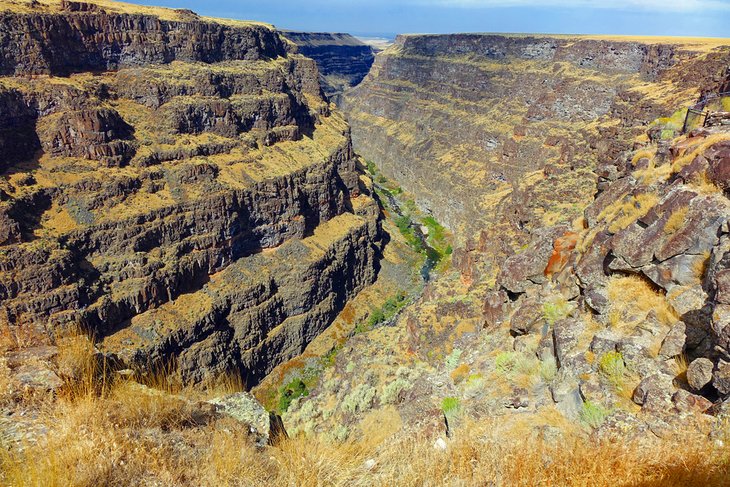
Bruneau River carves through 40 miles of an adventurous desert canyon in southwest Idaho. Paddling the white water of Bruneau River takes boaters through a stark red rock landscape found no other place in the state. A bit of a hidden gem, and a little hard to get to, Bruneau River offers a remote trip deep into nature.
It takes at least three days to paddle the Bruneau. The river is wild and untamed, and challenges like tree branches and portages line the route. Barker River Expeditions is one of a few outfitters offering full trips on the Bruneau, with a four-day option and a seven-day option that also hops on the nearby Jarbridge River.
Big waves span the 40-mile journey, including Class IV rapids like Cave Rapid and 5-Mile-Rapid. Deep within the Bruneau River Canyon's depths, an encompassing stillness is also a part of every trip.
Moyie River
The Moyie River is a hidden white-water stash in northern Idaho. Thirty minutes north of Bonners Ferry, this approximately 10-mile stretch of river is perfect for day trips. The moderate Class II-III rapids also make the river friendly for those new to the sport.
Any level of paddler enjoys the natural scenery along the Moyie. A narrow gorge of cedar and pine surrounds much of the route, and the relative remoteness also adds a nice wilderness touch to the experience. The season to run the Moyie is between May and June. ROW Adventure Center, out of Coeur d'Alene, is one of the few commercial companies that offer guided runs.
Despite the remoteness of the Moyie, the river is not difficult to access. Sandpoint is an excellent adventure basecamp an hour to the south. Sandpoint has grocery stores, restaurants, and places to stay the night. Spokane is two hours to the west, making the Moyie possible for a day trip from Washington.
Read More: Things to Do in Sandpoint, Idaho
Clearwater River
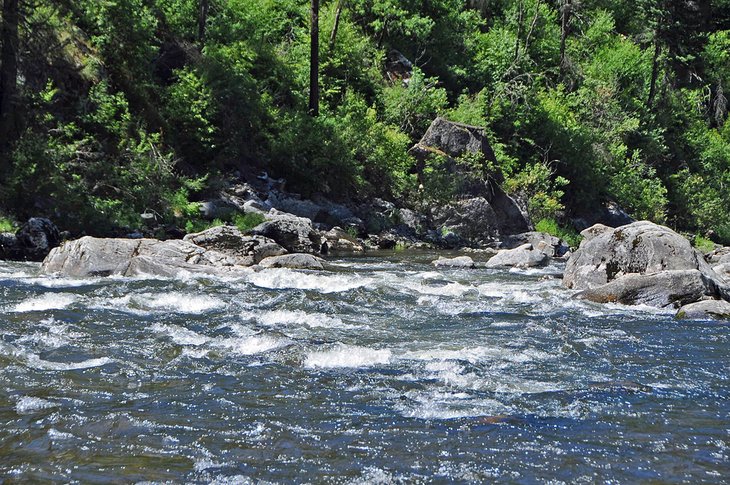
The Clearwater River in north-central Idaho is formed by the confluence of the Lochsa and Selway Rivers. The result of these two raging waterways coming together is a wide river with very mellow rapids. The smooth water and periodic Class I-II rapids of the Clearwater make it a great river for beginner and family paddling trips.
The river parallels Highway 12 much of the way, making ample choices for launching a boat or taking one out. The Clearwater River is typically done in a day. With subtle rapids and flat-water sections, the Clearwater River is also popular for other vessels like kayaks and stand up paddleboards.
A trip on the Clearwater is more of a scenic float than a white water wild ride. The calm water is enjoyable in this part of the country, thanks to the verdant mountain valley backdrop. The inspiring peaks of the Selway-Bitterroot Wilderness surround the river much of the way.


